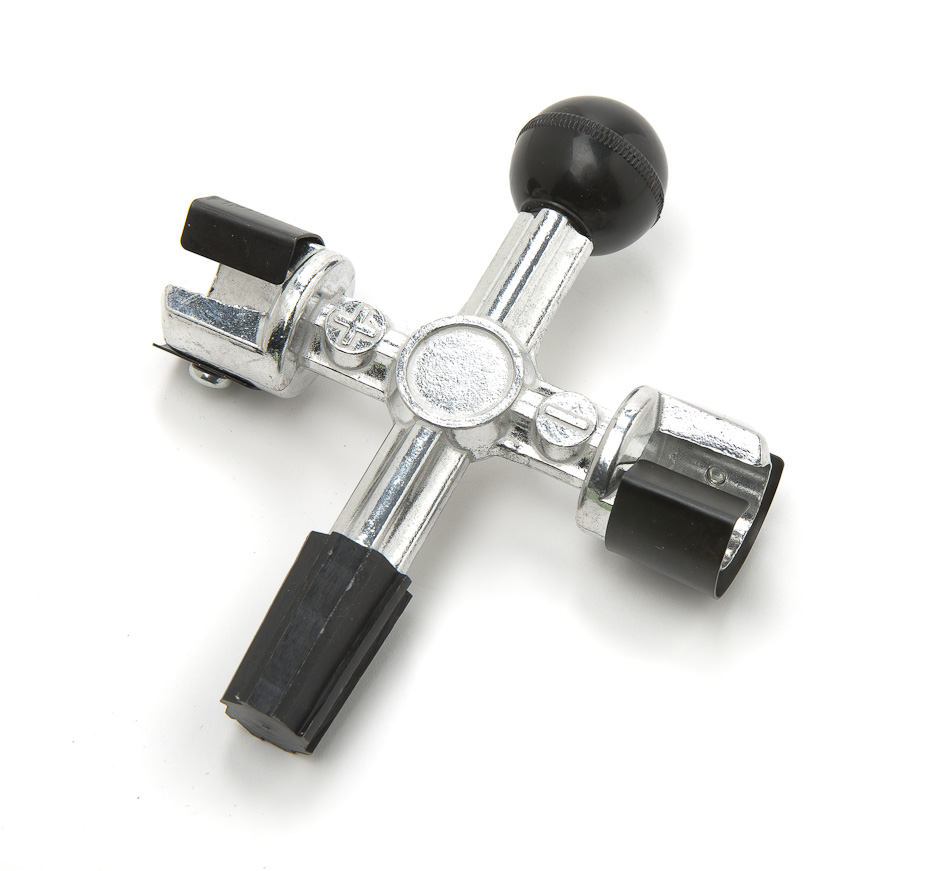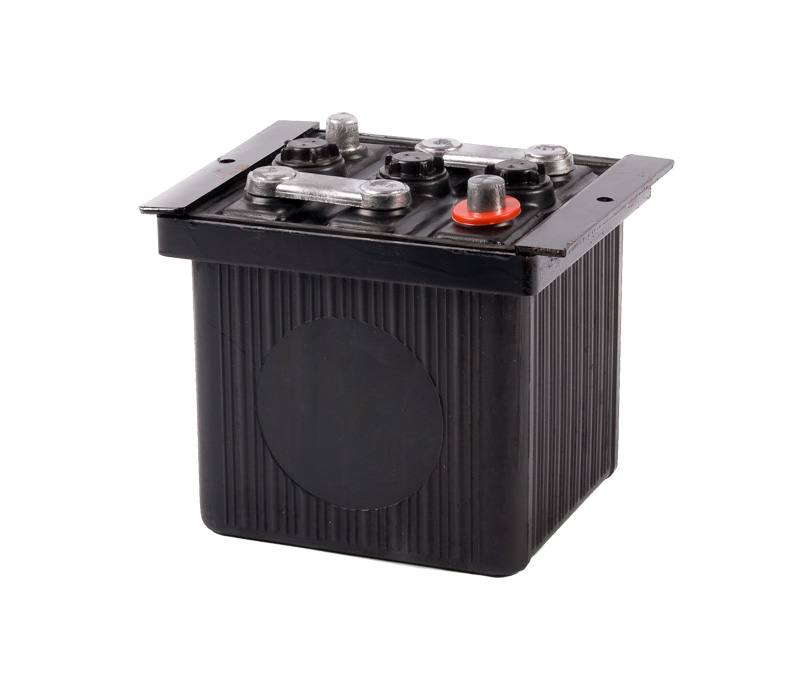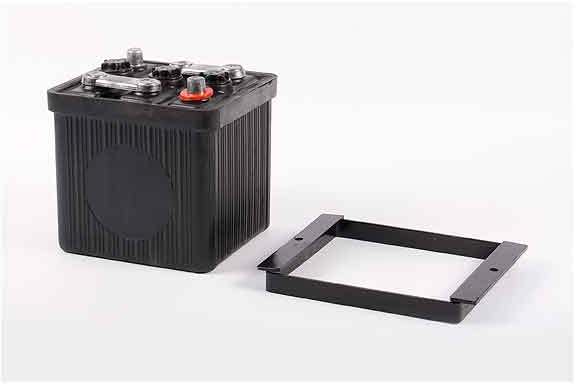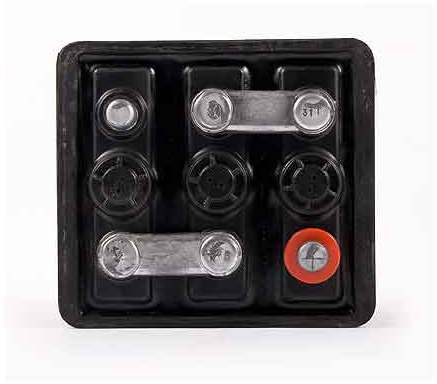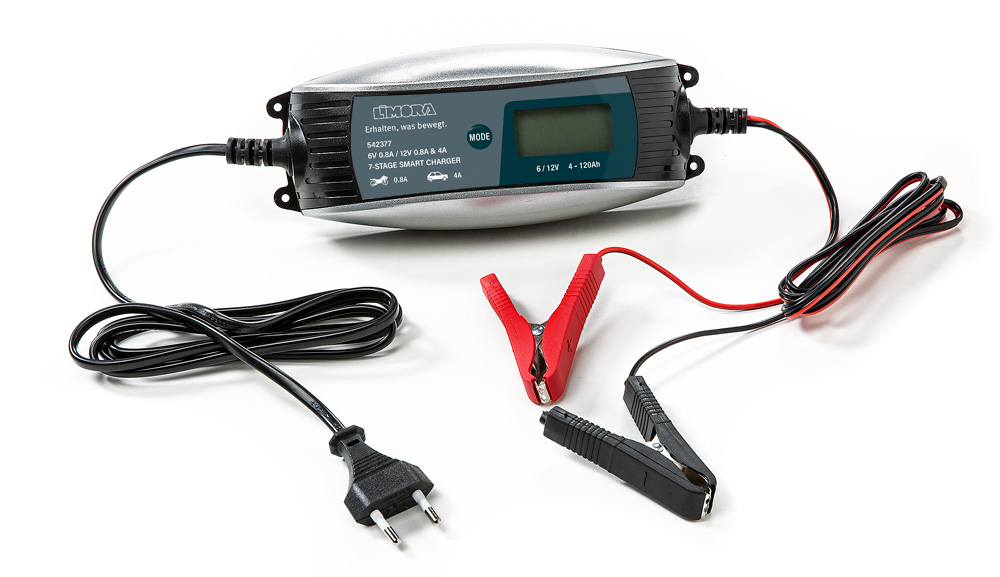Battery
Austin Healey: BN1, BN2, BN6 and BN7
Jaguar: XK120
classic black cased with metal frame with hole for J-bolt fixing, 6 volt, 58 Ah, dry charged. Dimensions: 7.4 x 6.7 x 7.5"". Identify by positive terminal front right
Batteries in the original, black Lucas look, supplied dry-charged. Available on mail order to your door.
Energized
The Battery tends to be ignored because it is generally reliable and does its job inconspicuously. It is one of the most important components of your car but is given a hard time and neglected by most drivers. The battery is basically a power pack and if treated badly it could end up exploding and spreading black powder and sulphuric acid around the battery compartment. Not much fun to clear this mess up. Better to pay a little care and respect to this inconspicuous block of plastic. Don't neglect to wear rubber apron, goggles and gloves. This is not being over-cautious or a sissy, its simply a better alternative to ruined clothes, burned eyes and nasty acid burns. The battery case of older cars is a good indicator of how corrosive battery acid is when left to itself. The battery compartment is susceptible to corrosion if you don't pay the necessary attention. You may not realise the extent of rusting until the corrosion is complete. Everyone knows what a vehicle battery looks like but few know how they work. Serious drivers will get to know the performance data of the battery applicable to their vehicle, but the majority of the owners have little knowledge of voltage levels, ampere-hours, power output, polarity of terminals. Those that know all this and understand the difference between maintenance free and non-maintenance-free battery are an exclusive handful.
So here is a little theory lesson.
Almost all cars and motorcycles from all countries have starter batteries which are lead-acid in an insulating - and of course acid resistant - housing. Modern batteries have a plastic housing, usually made of polyethylene or polyurethane, they are usually white though some long established manufacturers stick to black which was the colour of traditional battery cases well into the 70s. Lead-acid accumulator consists of a main housing containing a number of separate cells - each with a positive and negative connection. They are insulated agains short circuit
and consist of sheets of lead immersed in a solution of sulphuric acid. The lead plates are made with a lattice to the give a greater surface area and so greater charge storage capacity. The plates are packed with lead peroxide as an activator. Batteries consist of a number of cells each of which will have a 2 Volt charge. Rated voltage, three chambers for 6 V batteries, six for 12 V Batteries. These cells are connected in series, i.e. each positive connected to the negative of the next cell. The first and last terminals are the Negative and Positive terminals visible on the top of the battery case. In contrast to a parallel circuit where in all the positive poles are connected together and all the negative poles are connected. This gives a voltage equal to that of a single cell but with much higher current capacity. The series circuit adds the voltage of the individual cells together with only a marginal increase in current capacity.
The current is generated by two different metals which galvanise in an acid element. This chemical conversion process produces an electric charge. The metallic compounds used are the oxidising Lead Peroxide for the positive plates and metallic lead for the negative plates.
Electric current flows, when both poles are connected via an electrical circuit such as light bulb or other device such as a motor. Lead is dissolved from the negative plate and the positive plate by the acid to become lead sulphate This causes oxide to be formed on the lead plate surfaces. The density of the lead sulphate and acid decreases, until the plates become heavily made up of lead sulphate. Then the device must be charged by sending a reverse current through (from the alternator/generator). This reverses the process restoring the lead peroxide, metallic lead, reducing the lead sulphate and returning the specific gravity of the acid to its required level for further discharge. In normal driving operation charging electricity is provided by the alternator for resistant loading and unloading. Only the battery acid is altered by evaporation of the water content making it more concentrated. This necessitates occasional topping up with distilled water to dilute to the correct specific gravity. Maintenance-free batteries, have a system which ensures that the water vapour can condense and be recycled within the battery. The performance is calculated from the discharge current (A) times the time (h), in which a fully charged battery is discharged down to 1.75 Volts per cell. This is measured in ampere hours (Ah) With long periods of non-used the battery discharges by about one percent
per day, either by low current consumers such as the clock, or by the never entirely preventable leakage. Also various chemical processes will result in discharge. The battery with this pattern of non-use such as during the winter break should be regularly charged and discharged again. Also under load a further electrochemical reaction results in the water in the battery being split into oxygen at the positive terminal and hydrogen at the negative terminal. Well everyone should know enough chemistry to recognise the danger here. When these gases exist as a mixture 4% to 77% hydrogen content this is Oxyhydrogen known as a high-explosive mixture. Apart from the unpleasant aspects of smoking anyway you should remember that your battery might make your zigarrillos or pipes burn a little too brightly! Acid spray produced from an exploding battery is extremely aggressive and makes it sensible to wear protective eye covers for reasons other than fashion. The explosive property of hydrogen was demonstrated most impressively in 1937 in Lakehurst when a tiny electric spark was enough to ignite the "Hindenburg", the pride of the German airship fleet. Within seconds, a fireball and minutes later, a pile of ash. The fact that experts argue about it until today, whether the misfortune of an oxyhydrogen reaction or "just" burning Hydrogen is neither here or there.
If you look deeper into the home gadgets and older more modern vehicles you will be amazed that old six volt batteries were much more powerful than the modern batteries with twice the voltage. In the postwar years popular midsize cars like Borgward Isabella, Ford Taunus Opel Rekord, 6 V batteries with between 77 and 84 Amp were enough for a mid-sized car. In the 70s / 80s vehicles like Audi 80, Ford Fiesta or Opel Ascona needed 12 V consistently and 44 Ah, even if there is no power-hungry air conditioning installed. Power losses from oxidized or loose connections were less vulnerable when the electrical system had a higher voltage than with a higher current power supply with a lower voltage. A simple calculation: Only 2 V voltage loss means a 6 V system is down a whopping 33 percent, at 12 V this is less than 17 percent.
Cars with 6 V electrical systems need loving care and meticulous maintenance. Dim lights, tired indicators and brake lights are controlled by relays so should not be a weak point, but the result can be mass of errors, leakage. For operational safety reasons therefore, we eventually switched to 12v for new cars. Mercedes-Benz, Fiat and also some other manufacturers changed much earlier.
Another factor relates to the fact that higher voltage with less current requires much smaller cable diameters - a welcome side effect,
if one considers that the electric cars were becoming more established. The first generation of the BMW 7 already had some 6.5 kilometers (!) of power cable in it. Several kilograms of weight alltogether. For the same reason in commercial vehicles from mid-weight class for decades had 24 V rated voltage. Their large volume diesel engines and their powerful starter needed high current consumption needs as well so two
24 V batteries are connected in parallel. Batteries connected in series also occurred, often in lighter commercial vehicles in 2 x 12 V configuration, or as double 6 V unit among others MGB or Austin Healey. Long term heavy battery use will result in inevitable wear and tear.
The constant ups and downs, through shock and vibration can cause the the battery to shake and the plates will start to crumble. Eventually the resulting sludge on the bottom of the battery case reaches the plates. "Plate shorting" - an internal short circuit. So much for the theory.
In practice, you can do a lot to make working on the battery easier. With sudden battery failure- the following principles are always used,
especially if you are in a hurry - almost always the case.
1. Before removing or changing switch off all electrical devices and then loosen the earth wire first. In general, it is a braided, short copper strip. If you do the opposite, a conductive metal part, such as a wrench, could create a short circuit between the loose lead and the vehicle's framework.
2. Place the battery in a battery tray or on a battery mat which will neutralize any acid - so cheap and it may make an expensive battery box repair or garage reconstruction superfluous.
3. Use special, acid-free terminal grease. All other fats can inhibit current flow and promote corrosion.
4. Terminal washer rings are made of felt for a small cost, but contain acid leakage at the terminals. Their shelf life is limited so buy several.
5. Ensure bare metal contacts at the terminals. The current will only be flowing freely if contacts are free from oxidation. Otherwise the spark has to skip. The lower the voltage the less the spark will skip. Hence the greater attention needs of six-volt systems. Much better than scraping a round with a pocket knife or screwdriver - use the terminal brush or a special cleaning device with hardened cutting properties.
6. Tighten the battery terminals securely. For loosening tight terminals do not use a hammer nor any power wrench. With Battery-terminal one, it will loosen gently but vigorously and without the risk of damage to the battery case. Batteries with cracks in the case are junk!
7. Use terminal protectors as insulation. A car battery is so strong that a wrench placed onto both poles melts like butter in the sun. Also take care with items of decoration such as rings, bracelets, watches or metal. Keep them clear of voltage points or heat sources. Hands and forearms acts should be clear.
8. Measure the specific gravity of your battery regularly, as the specific gravity of the sulphuric acid, serves as an indicator of the performance of the battery: 1.28 g acid density per cm ³ at 20 ° C. Ambient temperature has a full, battery, at 1.24 g, it has only half strength, at 1.12 g, it is empty.
9. Protect yourself with items such as rubber gloves, apron and goggles from battery acid splashes.
10. Keep soap and water ready. If you get acid splashes on skin or clothes wash it off immediately. For splashes in the eyes wash with plenty of water and seek immediate medical help!
11. Use only distilled water to refill your battery. The minerals in normal tap water or spring water provide electrical conductivity within the battery, and so will soon ruin a battery.
12. Do not fill the battery water directly from the bottle into the Battery, not even with a funnel, and certainly not with a metal funnel that will have a detrimental effects on the sulphuric acid. Use a pipette to get in closer and without splashing.
13. Disconnect the battery from the electrical circuit of the vehicle when it is out of use for a long time, such as during the winter break.
14. Provide for regular breaks during which you should load and drain the battery, either by switching the battery to your everyday auto or connect a 2 watt bulb to the battery to discharge and then recharge from the charger. More easily consider a trickle charger, they simulated the charge discharge cycles and thus makes an ever-fresh battery guaranteed.
Accessory Battery
